|
This paper was written at the
request of Lord Napier and Ettrick for the Crofter Royal Commission, over
which his Lordship presided. Government have courteously granted the writer
permission to reprint a few copies to give to his friends.
Originally the paper was
meant to contain some account of the Geological changes, and of the Natural
History and Antiquities of the Outer Hebrides, but these not coming within
the scope of the Commission, Lord Napier found himself obliged to exclude
them.
The paper is hurried and
fragmentary, and contains but little of what might have been said of the
interesting people and customs of the Western Isles.
"The account of the old
customs is the most interesting thing in your Report; the old hymns are also
charming"- Extract of a Letter from a Nobleman in London to Lord Napier.
Alexander Carmichael.
GEOGRAPHICAL.
The Long Island comprehends a
series of islands 116 miles in length. The breadth varies from one mile to
twenty-six miles.
In shape the Long Island
resembles an artificial kite—Lews being the body, and the disarticulated
tail trending southward and terminating in Bearnarey of Barra.
A range of glaciated hills,
rising from the centre of Lows, and at intervals cut into by the Minch, runs
along the east side of the islands. Along the west side, washed by the
Atlantic, is an irregular plain of sandy soil, locally called Machair.
These islands are called the
Outer Hebrides, being the most westerly islands of Scotland, except those of
Saint Kilda. They form a breakwater against the Atlantic, from Cape Wrath on
the north, to Ardoamurchan on the south.
The Outer Hebrides were of
old called louse Gall, the Isles of the Gall, the Isles of the Strangers,
from the Norse Occupation.
The ancient name of the Long
Island, and still traced among the people, was louis Cat, the Island of the
Cat, or Catey. Who the Catey were is uncertain, though probably they were
the same people who gave the name of Cat Taobh, Oat Side, to Sutherland, and
Cat Xis, Cat Ness, to Caithness. May not the modern Clan Chatan be of these
people? They are called the descendants of the Cat or Catey, and have a cat
for their crest.
The present inhabitants of
the Long Island are essentially Celtic, with some infusion of Norse blood.
They are a splendid race of people, probably unexcelled, mentally and
physically, in the British Isles.
The populations of the
different islands form all of over 40,000 souls. Of these, forty families
occupy about two-thirds of the whole land of the islands, the numerous
crofters occupying the other third. These crofters retain pastoral and
agrestic modes of life, now obsolete elsewhere. To describe these modes of
life is the object of this paper.
All the crofters throughout
the Outer Hebrides occupy and work their lands on the Run-Rig System, more
or less modified. They work under this system its three different modes, two
of these being stages of decay. An example from each of these three modes
will be given from each of three parishes where they are in operation. This
the writer thinks is preferable to any general description which he could
devise. These parishes are Barra, South Uist, and North Uist, which form the
Southern Division of the Outer Hebrides.
Run-Rig.
The term Run-Rig seems a
modification of the Gaelic, Roinn Ruith— 'division run.' In this case the
word 'run' is used its the sense of common. In Gaelic the system of Run-Rig
is usually spoken of as Mor Earann—'great division,' or Mor Fhearann, 'great
land.' Occasionally, however, an old person calls the system Roinn Ruith.
This seams the correct designation and the origin of the English term
Run-Rig.
The system of Run-Rig
prevailed of old over the whole British Isles and the Continent of Europe.
It was common in Ireland, it is extinct in England, and obsolete in
Scotland, except to a limited extent in the Western Isles. There the system
still lives in three different forms, more or less modified—two of these
being gradations of decay.
Township.
The English word Township
represents the Gaelic word Bade, as applied to a rural locality and to a
country community. I, however, prefer the word town-land to township, having
already used it in the paper which Mr Skene asked me to write for his Celtic
Scotland, and which your Lordship was pleased to commend.
The word Baile, townland,
often appears in Origines Parochiales. This invaluable work is compilation,
by Cosmo Innes, from ancient charters and other historical documents
affecting the Highlands.
The word Baile occurs also in
Martin's Western Isles, published in 1703. Dr Johnson says that it was this
book that gave him a desire to see the Highlands of Scotland, and,
therefore, to this book the world is indebted for Johnson's famous Tour to
the Hebrides. A copy of Martin, which Johnson and Boswell had with them in
the Highlands and Islands, the writer has seen in the Signet Library,
Edinburgh.
I think the word Townland is
recognised by law. I have certainly seen it used in law documents. The
townland has a collective existence in various ways—by tradition, by usage,
by the condition of the people, by the consensus of public opinion, and by
the treatment of the proprietor. I shall endeavour to show this, and in
doing so shall confine my observations to the Long Island.
Maor.
The word Maor is old, and is
used in several languages. Before and after the tenth century it carried a
territorial title equal to Baron among the Highlanders and to the Jarl of
the Norwegians.
The name was then applied to
the governor of a province, whose office was hereditary, like that of the
king. The term Maor is now applied to a petty officer only.
Maor-Gruinnd is a ground
officer, he is appointed by the Factor—Gaelic, Baillidh—and acts under him.
On large properties the Maor is practically a sub-factor, and, being the
eye, the ear, and the tongue of the Factor in his district, he is often more
feared than the factor himself. Where the Factor is a non-Gaelic speaking
man, as has been the case on the Gordon properties, the people look on the
Maor with suspicion. 'The tongue of the people being then in another man's
mouth,' as one of themselves graphically said to me, they know not what the
Maor says or leaves unsaid concerning them. Nevertheless, there are and have
been ground-officers who were far from giving cause for such suspicion, who,
on the contrary, devoted their time and energies to the interests of
proprietor and people to the neglect of their own. Among these have been
some of the kindliest men I have ever known.
The Constable.
There is a Constable (Gaelic,
Constahal) in every town, and in some two— one representing the proprietor,
the other the people. Occasionally the Factor and the crofters elect the
Constable conjointly. More often, however, the Factor alone appoints the
Constable. When this is the case, the crofters murmur that the man thus
appointed and paid by the Factor alone is, unconsciously to himself
probably, too subservient to the Factor and too remiss in their concerns.
For this reason they elect a man to look after their own special affairs.
When a Constable is to be elected for the
townland, the people meet, and this and all kindred meetings are called
Nabac, 'neighbourliness.' If presided over by the Maor the meeting is
called Mod, Moot. If
the people meet during the day, they probably meet at a place locally known
as Cnoc Na Coinhairle—'The Council Hill,' or at Clach Na Coishairle—'The
Council Stone.' If they meet at night they meet in some central house on the
farm. Almost invariably these meetings are held at night, so as to avoid
losing time during the day. The meetings are orderly and interesting.
Not infrequently the man proposed for the
Constableship by his fellow-crofters of the townland declines the office.
Then another is proposed, and perhaps with like result. Ultimately the
people may have to cast lots all round before they get a man among
themselves to accept the office, the duties of which are distasteful to
them. In some townlands
the Constable is elected or re-elected yearly, in some for a term of years,
and in others for life.
The crofter having been appointed Constable,
takes off his shoes and stockings. Uncovering his head, he bows reverently
low, and promises, in presence of heaven and earth, in presence of God and
of men,—Am fianuis uir agus adhair, ant fianuis Do agus daoine, that he will
be faithful to his trust. In some places the elected Constable takes up a
handful of earth instead of uncovering his feet. The object is the same—to
emphasise, by bodily contact with the earth, that he is conscious of being
made of earth, to which he returns.
These and similar simple and impressive customs
are disappearing, to the regret of the old people and the antiquary.
The services of the Constable appointed by the
Factor are paid in money; those of the Constable appointed by the crofters
in kind—Fiar ant lseinn, agus peighiun air machair—grazing on hill and
tillage on machair. The
ditties of the Constable are varied and troublesome—requiring much firmness
and judgment. The Constable, however, can always rely upon the assistance of
one or all of his fellow-crofters as occasion requires.
The peat banks (Gaelic, Staihl, Poihl of the
townland) having become exhausted, the Factor or his Maor marks out a new
peat moss. The
Constable divides this into the necessary number of stances or haggs,
according to the number of tenants in the townland. For these stances the
crofters cast lots, as they do for their rigs of land. Lest a man should be
placed at any advantage or disadvantage from his neighbours, these stances
are again subjected to the lot (Gaelic, Crann), in the course of three,
five, seven, or nine years, as the people consider advisable.
A peat road (Gaelic, Utraid Moine) has to be
made to this new peat moss. Probably the road requires to be made over one,
two, or three miles of rock, bog, and moorland. It is the duty of the
Constable to see that every crofter in the townland gives the necessary
number of days of free labour, with his horses and carts, spades and
pickaxes, to construct this new road.
The Constable must see that all the roads of
the townland are kept in repair by the mutual co-operation of the crofters;
that no unnecessary traffic is carried over these roads during or
immediately after wet weather; and that the side and cross drains of the
roads run free. To
insure equal distribution of labour these bye-roads are divided into
Peighisnean, 'Pennis.' The good and bad, the soft and hard, the steep and
level parts of the road are thus divided and allotted. Each crofter must
keep his own portion in repair. Should he neglect, he is taken to account by
his neighbours, and his portion of road repaired at his expense.
The Constable engages the Herdsman and Shepherd
of the townland, apportions them ground for potatoes and here, collects and
pays their wages. These wages are self-levied on the crofters according to
their rent, as they have a whole croft, a half croft, or a quarter croft.
Every townland has a cattle fold on the machair,
and another on the gearry Gaelic, Gearruidh. In wet weather the Constable
instructs the herdsman to keep the cows to the machair, where the fold, from
the nature of the soil, is less wet and comfortless to the cows and the
women who milk them, than the fold on the gearry.
The Constable must see that the dyke enclosing
the cattle-fold is repaired in early summer before being used, and that the
gate is good and strong—Cadha Clsliadh na Cuithe. The term Cadha-Cliath,
literally signifies the gorge or pass wattle.
In wooded districts throughout the highlands,
where materials can be found, doors, gates, partitions, fences, barns, and
even dwelling houses, are made of wattle-work.
In the case of dwelling houses and their
partitions, the wattling is plastered over on both sides with boulder clay,
and whitewashed with lime, thereby giving all of cleanliness and comfort to
the house. Of old this
wattle-work was largely used by the Celts. It is believed that many of their
early houses and churches were made of wattling, and Mr Skene thinks that
Saint Columba's first church in Iona was so constructed.
One of the Gaelic name of Dubhis—Gaelic,
Dulsblinne, blacklinn '—is Bailath-eliath, 'the towis of the ford of
wattles,' the first bridge over the River Liffey having been constructed of
wattle-work. Probably
the interlacing so much used and so much admired in ancient Celtic art and
sculpturing had its origin in this wattle-work, occasionally called Celtic
basket-work. In carting
sea-weed up the shore, which is extremely trying upon horses, the Constable
sees that no man works his horse too heavily nor too long.
When he orders the people to stop work they
must stop. In some places there was a latent superstition and song the
people that the spirits of their horses were in communication with the
spirits of heaven. Probably this gave rise to their saying
Am fear bhitheas trocaireaeh ri anam
Cbs bhmithi c mi-throcaireach ri bhrmsid'
He who is merciful to his soul
Will not be unmerciful to his beast.'
The Constable must see to Cuartschiadh a Bhaile,
'rounding the townland.'
There being no fences round the fields, there is
danger that cattle or horses of their own or neighbouring farms may break
loose during night and damage the corn.
To guard against this, two of the crofters make
a circuit of the townland at night, each two and two of the crofters taking
this watching in turns during summer and autumn. This precaution is called
Cuartachadh, 'circuiting.' Should the watchers be remiss and damage to
result, the two crofters responsible must make good the loss. The damage to
the corn being appraised, the two crofters in fault pay it to the Constable,
who adds it to the general fund of the townland. Should cattle or horses
fruits a neighbouring farm cause loss, the owners have to pay the loss. The
people are exacting in recovering these valuations. 'Is e an cunntas
goirid,a dh-fliagas an cairdeas fada,' they say. It is the short accounting
that shall leave the friendship lasting, and they act accordingly.
Those, however, who are thus exacting in
pecuniary matters are, nevertheless, kind and considerate to one another in
other things. Should a crofter or his family be laid up ill, his
fellow-crofters help on his work. If a man's horse dies, his neighbours
bring on his work concurrently with their own, and, if necessary, help him
to buy another horse.
In connection with their watching, the people speak of a time when they had
to kindle fires to scare away wild beasts from their flocks, as they do now
in some localities to scare away deer and geese from their crops. These
fires look picturesque at night, and remind one of Campbell's beautiful poem
of the 'Soldier's Dream'—' fly the wolf-scaring faggot that guarded the
slain.' There is a
tradition in Lows of the last wolf slain there, and the place is pointed
out. Traditions of this nature are elsewhere.
I asked the crofters who said that they were in
the habit of sitting up at night to watch their corn from deer, if they
mentioned this hardship to their Factor. 'Yes,' said they, 'but he told us
that if we complained to him again he would 'clear us all out of the place,
so as to be out of the way of the deer. Therefore, we keep quiet, but
suffer.' The Constable
buys fresh stock, for the infusion of new blood for his townland, and sells
the old. He will not allow a crofter to cart sea-weed from the shore till
his neighbours have reasonable time to be there, nor will he allow a crofter
to cut sea-weed when and where he likes, He must see that the Run-Rig land,
Imire, of one man is not allowed to lie under water to the injury of the
man to whose lot it may fall at next allotting. The man must cut a drain to
allow the surface water to escape.
Should the crofters of the townland have
occasion to complain of a fellow crofter to the Factor, a deputation from
the crofters go to the Factor to prefer the complaint. The deputation is
represented by the Constable alone or in company. The Factor confers with
the Constable, giving instructions, and possibly removes the recalcitrant
crofter from his holding, should he continue to offend against the customs
of the community. The
Constable gives information to the people from the Factor as to days on
which the Factor is to collect rents and rates, as to new rules which the
Factor wishes enforced, or old ones he wishes more strictly observed, and
various ether things.
These are some of the duties devolving on the Farm Constable for the
orderly management of the Townland. In the past he had to assist the Maor
in evicting crofters, sometimes in evicting and pulling down the houses of
near and dear relatives.
There have been no large evictions in recent
years in the Western Islands, nor will there probably be.
Proprietors now visit their properties, taking a
kindly interest in their people, and Factors are more considerate. One of
these, indeed, is a man endowed with more excellency of head and heart,
without faults, than ordinarily falls to the lot of man, a man possessing
the implicit confidence of proprietors and tenants alike, who daily injures
himself to benefit them. Mr John Macdonald, Tacksman, Newton, berth Uist,
and Factor for Sir John Orde, will not forgive my mentioning his name, but
others will throughout the Highlands and Islands, where his name is honoured
among all classes. But
things were not always so in the Western Isles. Where a factor, in many ways
capable and excellent, in those days wished to acquire more land for
himself, relations, or friends he seems to have felt no more compunction in
destroying the well-being of scores of comfortable crofters, than were they
so many sheep. This was the common occurrence of the times.
Nor, incredible as it may seem, was it till
years afterwards that some of those absentee proprietors came to know, and
that accidentally, of these wholesale removals of scores of their peaceable,
loyal, industrious tenants, and of this practical destruction of hundreds of
their crofter population.
That these and many similar proceedings should
have paralysed the whole crofter population of the Western Islands was only
natural. Nor does it need a man to live and travel among the islands for a
quarter of a century to see and to be convinced that the people of those
Western Isles have not yet recovered from the effects of that paralysation.
Barra.
The Islands of Barra form an oblong group. Of
these islands, eight are inhabited. The Southern Isles of Barra were of old
called the Bishop's Isles, because they belonged to the bishop of the see.
The head of this wild precipitous chain of islands is still called
Bearnaraidh all Bearnarey of the Bishop, occasionally Barns head— Gaelic,
Ceaun Bharraidh. The
Southern Isles of Barra famed for birds. These are principally the Puffin,
Razorbill, and the Guillemote, Gaelic, Buigire, Dui'-eineach, and Langaidh.
The Manx Shearwater, Gaelic, Scrab, was extremely abundant there at one time
but since the advent of the Puffin, it is now practically extinct.
Both these last are burrowing birds. The Puffin
is vicious to a degree, his wonderfully strong, sharp, coulterneb bill
cutting keenly as a lance. Of old the crofters of Miuley paid their rents in
birds to 'Macneill of Barra. These birds were principally the young of the
Shearwater, and called by the people Fachaich, 'fatlings.'
The land was divided into crofts called Clitig,
Feoirlig, Leth-Pheighinn, and Peighitin. The Clitig is half the Feoirlig,
the Feoirlig is half the Leth-Pheighinn, and Leth-Pheighinn is half the
Peighinn, ' Penny'. The
Penny Croft paid two barrels, the Halfpenny Croft one barrel, the Farthing
Croft one half barrel, and the Clitig Croft one fourth barrel of Fachaichto
Macneill. Probably not
less than twenty barrels of these birds went to Macneill yearly, and all
from the small island of Griassamal, behind Minley
The proprietor came over to Minley a fortnight
before, and remained till a fortnight after Lammas Day—Gaelic, La Lunastain.
The people were not allowed to go to the rocks till he came; when he left,
they had the free range of the cliffs.
The people of the Southern Isles do not now kill
many birds, being too much occupied otherwise.
The people of Minley do not seem to have used
ropes as they do in Saint Kilda, but to have clambered among the rocks like
goats. These rocks are wonderfully grand. Mr Campbell of Islay and the
writer measured the highest of these in October 1871, when the barometer
showed nearly 800 feet above the sea. The place is named Aotsaig, and this
particular rock is called Biolacreag. The face of the cliff is as smooth and
perpendicular as the wall of a house, and goes sheer down into the Atlantic.
This precipice was the crest of the ancient
Macneills of Barra, and 'Biolarecag' formed the rallying cry of the clan.
There is probably no more
interesting island in Britain than this Island of Minley, with its wonderful
precipices, long narrow sea galleries, several hundred feet high in the
perpendicular sides, and marine arcades, winding their gloomy subterraneous
ways under the precipitous island. To boat through these galleries and
arcades needs a calm sea, a good crew, and a steady nerve. The writer was
the first to discover, and the first and the last to go through much the
longest, largest, and gloomiest of these wonderful sinuous sea arcades.
The Macneills of Barra lived in a castle on a
tidal rock called Ciosmal, in Baile Mhicneill, Macneilitown, now called
Castlebay. There are two wells within the walls of this old castle. The
people say that the water of these wells conies in pipes under the sea, the
pipes being overlaid with large flags.
Some fifteen years ago, the then Factor let the
castle as a herring-curing station, when the principal well, in the centre
of the court, was filled up, and the chapel in the west corner carried away
piecemeal as ballast for boats and vessels. The native people, who still
fondly cling to the memory of their once proud chiefs, were grieved at the
destruction they were powerless to prevent.
The site of Ciosmal Castle had been the site of
a magazine, wherein the Norsemen kept war materials during the Norse
Occupation of the Western Isles.
Ciosmal was abandoned by the Macneills during
the first quarter of last century. They built houses in three other places,
finally settling at Eoligearry, on the north end of the island. The family
became extinct in the direct male line in Lieut.-General Roderick Macneill.
It is said that so symmetrical in person was General Macneill that 'no eye
looked at him without looking at him again.' He was adored by his people,
who, with the fidelity of their race, ruined themselves in trying to save
him from ruin. They gave him their all.
To Dr Macgillivray, the people of Burra are much
indebted, and this they gratefully acknowledge. Since he became tacksman of
Eohigearry, some forty-four years ago, probably he has given in one form
or another some £7000 in work to the people of Barra, while his skill and
his medicine are ever at the disposal of all. The eminent naturalist of that
name was brother to Dr Macgillivray.
A curious custom prevails among the people of
Burra of apportioning their boats to their fishing banks at sea, much as
they apportion their cows to their gracing grounds on land. The names,
positions, extent, characteristics, and capabilities of these banks are as
well known to them as those of their crofts.
The people meet at church on the 1st day of
February—Gaelic, La-Fheill Bride—the Festival of Saint Bridget; and having
ascertained among themselves the number of boats engaging in the long line
fishing, they assign these boats in proportionate numbers among the banks
according to the fishing capabilities of each bank. The men then draw lots,
each head-man drawing the lot for his crew, and thus the boats are assigned
to their respective banks for the season.
Should a bank prove unproductive, the boats of
that bank are considerately allowed to distribute themselves among the other
banks, the boats of which are then at liberty, to try the deserted banks.
The fishermen say that the ways and migrations of the fishes of the sea are
as unaccountable as those of the fowls of the air—here to-day and there
to-morrow. They say also that fishes resemble birds in their habits, some
fishes, as the Cod and the Conger, in being solitary, like the Raven and the
Skits; while some other fishes, as the Saithe and the Herrin 'a' are
gregarious in their habits, and live in communities, like the Razorbill and
the Guillemote. I am indebted to the intelligent and observant fishermen
throughout those islands for much interesting and curious information
regarding fishes and sea birds.
Having completed their balloting, the fishermen
go in to church, accompanied by fathers and mothers, brothers and sisters,
wives and children, and sweethearts. The good priest says a short service,
wherein he commends those 'who go down to the sea in ships' to the
protection of the holy Saint Barr, after whom Barra is named, of the
beautiful Saint Bridget, 'virgin of a thousand charms'-' Bride bhoidheach
oigh nam mile bens '—on whose festival they are met, of their loved Mother,
the golden-haired Virgin, and to the protection, individually and
collectively, of the Holy Trinity. The people disperse, chanting-
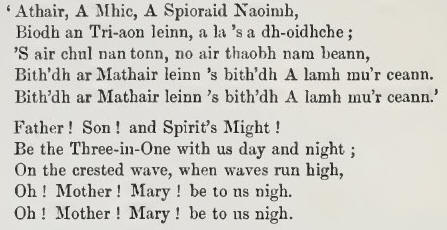
Having dispersed, the people repair to their
homes, on the way thither eagerly and simultaneously discussing the merits
and the demerits of their respective banks. To hear their loud and
simultaneous talk, one would think that the people were quarrelling. But no,
this is only their way—the Barra people being peaceable and gentle, and
eminently well-mannered and polite.
This habit of the Barra fishermen of
apportioning their fishing banks may seem antiquated to modern views. The
fishermen themselves advance good reasons for its retention, some of these
being that it prevents overcrowding of boats on the banks, with the
consequent entanglement of lines, resulting sometimes in the loss of temper
and friendship.
In the Inverness courier seventeen years ago, or
so, the writer suggested converting the strait between Barra Head and Minley
into a harbour of refuge, by throwing a break-water across the west end. A
harbour there would be of inestimable benefit to shipping and fishing.
Third Stage of Run-Rig.
The arable land of the crofters of Barra is all
divided into crofts, no part being in common. The grazing grounds only are
held in common, each townland being confined to its own grazing limits. The
crofters of each townland have their own herdsman, and regulate their own
townland affairs with no interference from without.
SOUTH UIST.
The Island of South Uist forms an oblong, with a
range of high hills on one tide, and long level low-lying moors and machairs
dotted with shallow lakes oil other side. The people live oil side. In the
time of the Clanranalds, the crofters had the hills for their sheep and
cattle, and they say that they were very comfortable. Since then the greater
and best part of the machair has been cleared of crofters, and their
townlands converted into large farms, with the whole of the hills added
thereto. Some of the evicted people were chased among the hills, caught,
tied, and shipped like felons to Canada, against which the Canadian press of
the day raised a strong protest.
The rest of the evicted crofters were thrust in
here and there among the other crofters, who were made to share their rocks
and morasses with them. And there they are—'Na biasta mom g-itheadh cam
biasta beaga, agus na biasta beaga deanamh mar a dh fhaodas iad '—The big
beasts eating up the little beasts, and the little beasts struggling as best
they can--, the survival of the fittest.'
One acquainted with these islands is struck with
the coincidence, possibly occidental, that the large farms are made from the
best crofter townlands, while the crofters are huddled together, generally
among rocks and bogs. No crofters have been removed for the present highly
respectable and intelligent tacksmen of the Long Island.
When the crofters had the hills, they migrated
to them every summer season with their flocks. They remained in the hills
till their corn was ripe for shearing when they and their cattle returned to
the townland—Gaelic, Baile. Apart from the benefit derived by the flocks
from the change of grass, the grass 'at 'home' thus left free was of
inestimable advantage to the stock during autumn and winter. The stock
needed but little house feeding, and that mostly during spring.
The crofters say that the change from the
malaria of the plains to the bracing air of the hills was of benefit to
themselves, and that as a consequence complaints common among them now were
then unknown. They talk with delight of the benefit they derived in mind,
body, and substance from their life among the hills. I entirely agree with
them, and believe that these shrewd people are quite equal to their critics.
There is one place of which the old people speak
with particular favour. It is on the Factor's farm of Ormacleit, out at the
mouth of Lochaoineart, and at a place called Airi-nam-ban, the 'shealing of
the women.' There had been a religious house here in the olden times, and
from this circumstance the place is named.
These holy sisters had always the good taste to
select or get selected for them the best situations for their dwellings.
This place is no exception. One of the many beautiful descriptions of a
beautiful place, in the old Gaelic tales, runs thus--
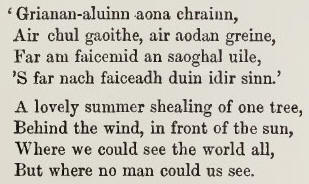
Here the good nuns had such a place to their
heart's desire. Behind rises Benmore 2030 feet high, the base of it winding
round this beautiful spot, and sheltering it from the west, north, and east.
In front is the Minch and the sea away as far as the eye can reach beyond
Coil and Tiree, dotted with white sails bending in various directions. On
the left is Skye, with the snow-capped Coolin Hills, their serrated peaks
piercing the ever changing clouds; while ranged away to the south are the
hills of Araoaig, Ardnamarchan, and of Mull, in the foreground of which lie,
stretched in broken chain, the peaks of the Small Isles and the low-lying
Islands of Coll and Tiree. Right below this beautiful summer shealing are
ivy-clad sea precipices of great height, the home of the king of birds -
Righ-nam-Ian, the Golden Eagle. The fine anchorage, close below to the
right, is the sporting ground of varieties of fish. The bent back of the old
man who spoke of this place to me first straightened up; the dim blue eyes,
which had seen the changes of ninety-nine years, sparkled with light, and
the weak voice trembled with animation as he graphically described the place
to me, and the joyous life they lived at the shealing there,
'In life's morning march, when his bosom was
young.'
The smoke of the whole people, nuns and all, now
ascends through the chimney of a single shepherd.
Highlanders are essentially musical. Of old they
had songs for all the avocations in they engaged, particularly for love,
war, and the chase. Many of these are beautiful—all are chaste. They had
labour songs, with which they accompanied themselves iii rowing, shearing,
spinning, fulling, milking, and in grinding at the quern. If they sing less
now, their silence is due to repression from without.
The tendency of modern cultured life is to have
prayers and hymns for special occasions. These old people, whom it is the
fashion for those who know them best to condemn, had special prayers and
special hymns for every occasion.
Correctly speaking, the hymns and prayers were
one, the prayers being rendered into rhyme to help the memory. There was a
special prayer on going to sea, a special prayer on to the shealing, a
special prayer for resting the fire at night, for kindling it in the
morning, for lying down at night, for rising up in the morning, for taking
food, for going in search of sheep, cattle, and of horses. for setting out
to travel, and for other occasions.
These hymns having been asked for by members of
the Commission during their Inquiry, a few are given at the end of this
paper.
Lying across the north end of South Uist proper,
and separated by a ford nearly a mile wide, is the Island of Benbecula—Beinu-nam-faothla—'hill
of the fords.' Stretching out from the south end of the Island, and across
the east end of the Sound of Barra, is the rocky island of Eirisgey, whereon
Prince Charles landed from France when he came to claim the crown of his
fathers in 1745. These Islands are in the parish of South Uist.
On a rock above water mark is a sandy knoll
whereon he scattered, on landing, the seed of a Convolvuous major. The seed
grew, and the plant has spread over the place. The flower is pink, with a
mauve tinge, and is very pretty. A patriotic gentleman from Harris, Dr
Robert Stewart, built a wall round Coilleag a Phrionns, the 'Knoll of the
Prince,' as the place is called.
Seven miles north from the south end of South
Uist, at Airi-mhuillinn—the Mill Shealing'—are the ruins of the house where
Flora Macdonald was born. In the neighbourhood is a boulder where she met
the Prince by appointment when she undertook to take him to Skye. Should not
these places be marked and held sacred for all time coming?
Six miles further north is Houbeag, where was
born Neill MacEachain, father of Marshal Macdonald, Duke of Tarentum. This
tribe of the Macdonalds is locally called Mac Eachain. Neill Mac Eachain was
the son of a small farmer at Houbeag. He had been educated for the
priesthood, but did not take orders. He had been schoolmaster for the parish
and was acting as tutor in the family of Clanranald, when Lady Clanranald
sent him to Skye with Flora Macdonald and her Irish spinning maid 'Betty
Burke,' the Prince.
Neill Mac Eachain followed the Prince to France,
where he changed his name back to Macdonald. He married, and his son
entering the army, rose to the rank of Marshal of France and Duke of
Tarentum.
In 1825 Marshal Macdonald cause to South Uist to
see his relations. On coming in sight of the river, near which his father
was born, he raised his arm, and exclaimed 'That is the River of Hough. I
know it from my father's description. Many a salmon my father killed there.'
On meeting his blind old uncle, he embraced him affectionately, and granted
him and his daughter an annuity, and gave to various other relatives sums of
money.
He took potatoes with him from the garden his
father's father had, and earth from the floor of the house wherein his
father was born. This earth was, by his orders, put into his coffin when he
died. He parted with his relatives with many mutual regrets. That was a
great day in Houbeag!
Right across the hills from Houbeag, after a two
hours' walk, is Corradal, in which is the small cave where Prince Charles
lived in hiding, Po Choihl, 'under the wood,' as the people say, for six
weeks. The cave is in the face of a rock on the north side of a narrow glen.
Chambers says that about ninety persons knew
that the Prince was in Corradal. He might safely have said nine hundred, yet
no one attempted to betray him. The place was full of crofters then, though
there are none now within many miles. The Rev. John Macaulay, grandfather to
Lord Macaulay, was minister in the parish at the time.
Intermediate Run-Rig.
The low-lying district of bear, 'nether,' is a
narrow strip lying across from sea to sea on the extreme north end of South Uist.
It is bounded on three sides by the sea, and on the fourth by a large
farm. This district comprehends nine townlands, and an aggregate of
eighty-eight crofters. Each of these crofters has a distinct croft of his
own in his townland, and a share in the arable land common to the whole
crofters of the district.
The crofts of the townlands lie towards the
middle of the district. On the east, between the ragged townlands and the
Minch, lies a moor interspersed with rocks, bogs, and water. 'Where the land
is not rock it is heath, where not heath it is bog, where not bog it is
black peaty shallow lake, and where not lake it is a sinuous arm of the sea,
winding, coiling, and trailing its snake-like forms into every inconceivable
shape, and meeting you with all its black slimy mud in the most unexpected
places. The crofters of the district send cattle here in spring and early
mummer, if driven by necessity from want of provender, not otherwise. The
moss, particularly at one place, contains much Sundew, Drusera rotuniforia,
and this the people affirm causes Red 'Water—Gaelic, Bun Deargin their
cattle. The various names the old Highlanders had for this plant indicate
that they understood its carnivorous nature before Darwin's discovery. The
plant was called Los a Ghadmuin, in reference to its qualities as a hair
wash, Lus an Deoghail, from its sucking qualities, and Lus an Dioglain, from
its titillating, tickling nature. The crofters themselves cultivate no part
of this moor, but numerous squatters sent and settled there do.
Between the rocky, boggy, water-logged townlands
and the Atlantic, is an extensive plain, locally called Machair. This
Machair, like the moorland, is held in common by all the crofters of the
district Some portions of the Machair are cultivated, some are under
grazing, and much is incapable either of cultivation or grazing, being
simply sterile sand.
For economic purposes, the eighty-eight crofts
of the district are divided into four sections of twenty-two each. These
sections or wards are presided over by Constables, and the whole district is
presided over by a Maor.
The cultivated parts of the Machair are
periodically allotted among the eighty-eight crofters. This is done at
Hallowmas—Gaelic, Samlinin. The Scat, Clar, or Leob, as the undivided ground
is called, is divided into four quarters.
These quarters are ballotted for by the
Constables of the Townlands for their respective constituencies. This
accomplished, the Constables, aided by the people, the whole supervised by
the Maor, subdivide their respective sections into the necessary number of
rigs or ridges—Gaelic, Imirean, or lomairean.
The crofters cast lots in their respective
wards, and the rig which then falls to a man he retains for three years. At
the end of that time the whole cultivation is again let out in grass, and
fresh ground broken in as before.
During summer and autumn, the flocks of the
whole community graze over these Machairs, herded by one or two herdsmen as
occasion requires.
While each crofter sends more or less stock to
the district grazing of the machair, he probably grazes fewer or more cows
and horses on the uncultivated portions of his croft at home. These are
tethered or tended by a member of the crofter's family.
There being no fences in the district of Iocar,
except those built by the late Rev. Father James Macgrigor, the gaunt cattle
and horses of the crofters roam at will when the crops are secured. In their
intense struggle for existence, these crofters keep far more stock than
their crofts can all adequately maintain. They do not act upon their own
proverb, 'Is fearr aon laugh na da chraicionn,' One calf is better than two
skins. They give the food to their cattle and horses that they so sorely
need for themselves. Considering the quantity and quality of their land,
that the cottars living upon them are nearly as numerous as the crofters
themselves, while many of these keep nearly as much stock, that practically
they support their own poor, and several other considerations that must be
taken into account, probably these crofters pay four times the rent paid by
the large farms; not that the large farms are under-rented; that as a whole
they are not. That the Iocar crofters exist at all is only an evidence of the
tenacity of their race. As one of themselves said—'We take a deal of
killing, or we would have been killed out long ago.'
Of the dykes built by Mr Macgrigor no praise is
too good. Mr Macgrigor was the priest of probably the most depressed
congregation in Scotland. Yet during his incumbency of over forty years he
showed a more admirable example to the people how to improve their crofts
than all the proprietors, factors, and tacksmen put together. He built
several miles of the most excellent enduring stone dykes round and across
his croft, while it is computed that more stone is hid underground in drains
made by him than appears in these dykes. And all these stones, together
with those that went to build his chapel, chapel-house, and outhouses, Mr Macgrigor quarried from the rocky hillocks and erratic boulders that
literally studded the face of the land when he came to the place. This land,
so well laid out in parks, is now equal to any in the Western Isles for
cropping and grazing.
Mr Macgrigor lived on plainest fare in order to
improve his place. He personally superintended the digging and filling up of
every drain, the building of every dyke, and the constructing of every
house, while nothing delighted him so munch as to see boulders and rocks
breaking down before his fire, gunpowder, and crow-bars.
The good works that this poor priest
accomplished above and below ground, and as a skilful medical man among all
denominations, and in social life, are marvellous. Nor are they 'all
interred with his bones.' Mr Macgrigor was the last professor in the
Catholic College of Lismore. In that island he is still remembered.
Mr Macgrigor was warmly loved and welcomed
wherever he went, and nowhere more warmly than by the excellent family of
the then minister of the parish, the Rev. Roderick Maclean. Mr Maclean,
being an excellent classic, as well as an excellent man, read from the Greek
and Hebrew Texts to the last. He and Mr Macgrigor were warm friends, and
perhaps no more graceful act was ever done by the minister of one
denomination to that of another, than was done by the parish minister to the
priest. The then factor was depriving Mr Macgrigor of his croft and
confiscating his improvements. The minister of the parish, the only man who
could do so with safety, used his good offices with the absentee proprietor,
and Mr Macgrigor, to the relief of every person, was let alone.
A subsequent factor nearly took the place from Macgrigor's
successor, not because this lamb himself was accused of disturbing the
water, but because, as the factor alleged, erroneously, however, that
another lamb of the same kind, in a distant fold, was. Better
counsel prevailed, however.
These and similar cases show the need of
security against arbitrary evictions, at the hands of men whose own despotic
will is their law. When men so offenceless, so respected and beloved by the
whole community, so narrowly escaped, what chance had obscure crofters who
had no one to speak for them?
What improvements on lands or on houses can be
expected under such conditions, and in the absence of proprietors or
propriotrixcs if misled, however well meaning?
Dr Alexander Macleod, commonly called An Dotair
Ban, from his fair hair, was factor over the South Uist estates for a few
years. During his altogether too brief factorship, Dr Macleod conceived and
executed many schemes of great originality and utility for the improvement
of the estates. Among other things be placed stones along the strand for
growing sea-weed; he planted bent, Gaelic, Muran, over hundreds of acres of
sterile sands that are now smiling machairs and he cut canals—Gaelic,
Ligeadh—from lakes to the sea, whereby he drained vast tracts of land
hitherto under water. On these canals he placed ingeniously constructed
self-acting flood-gates, to let out the fresh and to keep out the salt
water.
Instead of draining the estates of their money,
like others, Dr Macleod endeavoured to drain them of their water, while the
many wonderful improvements he effected over these estates testify to his
success, and indicate what the estates would have become under his
management.
When Colonel Gordon of Cluny heard of his death,
he wept, though not much given to weeping, and said —'I have had many halflins, but never a whole factor except Dr Macleod.'
The people of the Western Isles still speak with
admiration of Dr Macleod's, head and heart, and of his medical skill.
The people of the Gordon estates had great faith
in the ability and integrity of Mr James Drever, now of Orkney, for the
improvement of the impoverished estates and people, and they still regret
his resignation of the factorship.
NORTH UIST.
All the crofter land in North Uist, except that
of three farms, is held and worked on the Intermediate System of Run-Rig.
This system has been described in South Uist, The three farms in question
are those of Hosta, Caolas Paipil, and Heisgeir. These three are still used
and worked entirely on the Run-Rig System, and probably they are the only
examples now remaining in Scotland, if not in the British Isles, of this
once prevalent system of holding the land and tilling the ground. And,
perhaps, it is in the fitting order of things that these, the last lingering
footsteps of this far-travelled pilgrim from the eye of day, should here
sink down on the bosom of endless night, where the last rays of the setting
sun sink and disappear in the mysterious fading horizon beyond. But this is
a practical age, and these are day dreams I am no advocate for the retention
of a system now effete, and yet I cannot help heaving a sigh of regret on
seeing a system, once and for ages, the land system of millions of the human
race, now disused, discarded, and disowned, disappearing, and for ever, on
shores of those eerie Western Isles, washed by the Atlantic tide, whose
waves pour their dirge-like strains over the dying, while the voice of
Celtic Sorrow wails on the lonely ear of Night-
Cha till, cha till, cha till ml tuille
I return, I return, I return nevermore
The townlands of Heisgeir, Caolas Paipil, and
Hosts are worked alike. The first contains ten, the second six, and the
third four tenants.
These three farms were of old occupied by one
tenant in each. When they were let, one after another, some years ago to
small tenants, these new tenants adopted the Run-Rig System in its entirety,
as the system best adapted to the circumstances of their position. Nor must
they be condemned in this without taking all the circumstances of their
position into consideration. Moreover, those men are probably as well
qualified to judge of their own requirements as any person likely to sit in
judgment upon them.
Heisgeir.
Heisgeir is a low-lying sandy island in the
Atlantic. It is three miles in length, and a mile and a third in breadth at
its broadest. When the tide is in, the island is divided into three by two
fords that cross it; while beyond it lies the Island of Seiley, separated by
a strait a third of a mile wide that never dries. Heisgeir lies four and a
half miles from North Uist, to which it belongs.
The island is variously called Efeisgeir,
Teisgeir, and Asisgeir. The last form is the key to the meaning of the name,
but the first being the most common form I shall adhere to it.
Aoi is a Gaelic name for isthmus. An isthmus,
Aoi, connected the island of Heisgeir with the mainland of North Uist.
The isthmus was called Aoi, as similar places
are still called. But, partly through the gradual subsidence of the land,
and partly owing to the gradual dislodgment of the friable sand forming the
isthmus, the isthmus by degrees gave way to fords, and the fords broadened
into a strait four and a half miles wide and four fathoms deep. Tradition
still mentions the names of those who crossed these fords last, and the
names of persons drowned in crossing.
As the isthmus gradually disappeared, the name
Aoi disappeared with it, and became attached to the peninsula beyond it, now
an island. A similar process is going on elsewhere, and under precisely
similar conditions.
And this I take it is the way in which the
island of Iona acquired its present Gaelic name. This sacred isle is called
in Gaelic, I Chalum Chille, and which is usually translated 'Isle of Columba
of the Churches.' As there is no such word in Gaelic as I for an island.
Therefore, I take it that I is simply a pronunciation of Aoi, and that this
correct Gaelic name of Iona is, Aoi Chahuss Chille. Iona was called Aoi in
the year 1088.
That Iona because an island as Heisgeir became
en island is extremely probable. Perhaps there was less subsidence of land,
but that a sand isthmus connected with the opposite shore of Mull must
be evident to any person who examines the place at low water.
Nor does it militate against this theory that
the formation on the Mull side is granite, while that of Iona is gneiss.
That the heavy Atlantic surf, ceaselessly
beating against a bank of friable sand should ultimately destroy it is only
natural. The process is going on at various places along the West Coast. I
know men who ploughed and reaped fields now under the sea.
The island of Heisgeir is called Heisgeir Nan
Cailleach—'Heisgeir of the Carlins.' A community of Nuns lived here in
connection with Iona. These good Nuns lived there far into Reformation
times, and only died out from natural decay. The site of their house was
pointed out to me by a lonely old woman who lived on the spot, and who, from
her aged appearance, might almost have been the last remaining link between
them and us.
Divided by a strait a third of a mile wide, and
beyond Heisgeir Proper, is Heisgeir Nam Manach—'Heisgeir of the Monks.' The
whole extent, rocks included, is half a mile long and half a mile wide. A
monastery stood in the olden times where the lighthouse now stands. And I
think it is but simple justice to the memory of those good monks of old to
believe that they were actuated from pure motives of humanity to build their
house on that wild bare bluff to warn passing vessels of their danger. The
lighthouse serves the same purpose now.
This is the nearest island to Saint Kilda, and
is known to mariners as Monach, but to the natives as Seiley. Seal
.isle--Norse. Before the lighthouse was built the island and the rocks
around it were much frequented by seals. They have now deserted the place.
Shipping is indebted to Mr John Macdonald, Newton, for having drawn the
attention of the Lighthouse Commissioners to the need of a lighthouse on
this highly dangerous coast.
One summer day long ago, all the men and women
in Heisgeir went to Seiley to shear sheep. having landed their wives on
Seiley, the men went to a tidal rock near hand to kill seals. In their hurry
to club the seals on the rock they omitted to secure their boat properly,
and the boat drifted away before the wind. The women had no boat with which
to rescue their husbands, and the tide was flawing rapidly. The cries of the
distressed women were heard by a woman on the opposite side of the strait.
End by end this brave woman took down from above water mark a large boat and
pulled it across to her agonised sisters. But alas, too late! The Atlantic
waves rose mountains high, as they can rise only round this coast, and the
men were swept off the rock one by one and drowned before the eyes of their
wives. Some of their wives lost their reason, some their health and
strength, and died of broken heart. Such is the tradition in the place.
The flesh of the seal is called Carr in Gaelic.
This is probably the root of Cardhus—Lent--from Carr-Dhiosg,
flesh-weaning, or Carr-Thraisg, flesh-fasting. The flesh of the whale is
also railed Carr, but the flesh of no land animal is. It would be curious to
trace the cause of this distinction.
The people of Uist used to eat seals. One of
their proverbs is—
'Is math am biadh femanaich
Aran sea-ail agus saill ruin.'
'Good food it is for sea-weed worker
Rye bread and blubber of seal.'
The seal blubber was cut into long thin strips.
These were placed on a table. A board, with heavy weight on top, was placed
over the strips of blubber to press out the oil. The people's tastes have
changed, and they do not now eat seals. Probably the monks of Monach used
seal flesh for their table, and seal oil for their beacon lights.
The hapless Lady Grange lived in Heisgeir before
she was sent to Saint Kilda.
Run Rig Wholly.
All the land in Heisgeir is held in common by
all the tenants of the island. There are no crofts, and consequently no
portion of the land is permanently held by an individual tenant. There are
ten tenants, and two of these having two shares each, the land is divided
into twelve shares.
About Hallowtide—Gaelic, Samhuin—the ten tenants
of the island meet for Nabac,' neighbourliness.' Probably the only thing to
be done at the neighbourly conference is to decide upon the piece of ground
to be broken up for cultivation. This foregone conclusion decided, the men
proceed at dawn of day to divide the ground. The land to be divided is
called Scat, Clar, or Leob.
The Constable takes a rod and divides the Scat
into six equal divisions. At the boundary of each division he cuts a
mark—Gaelic, Bourn—in the ground, which is called by the curious name of
Tore. The Tore resembles the broad arrow of the Ordnance Department.
The word Tore signifies a notch, and is applied
to cattle whose ears are notched. These notch-eared
cattle—'Tore-Chluaaach'—are frequent in the Western Isles, and are spoken
of as 'Shoe a Cliroidh Mhara,' the descendants of the fabled sea cattle.
The Constable, having marked off the Scat or
Clot into six divisions, with the willing aid of his fellow-crofters, sends
a man out from the people. Probably the man sent out of the way is the
herdsman, who has no personal interest in the matter. Each of six men then
put a lot—Gaelic, Crams—into a bonnet. The man sent out is then recalled,
and the bonnet is handed to him. From this the man takes the lots, and
places them one after one on a line on ground. The order in which the lots
stand on the ground is the order in which the owners of the lots stand to
one another in the shares. Each man knows his own mark, and care is taken
when putting them into the bonnet that no two be alike.
The two tenants who have double shares, retain
their two shares each. The other four tenants subdivide their divisions with
the other four men whom they represent. These subdivisions are called,
Imiresn or lomnairean, rigs or ridges. Each two tenants cast lots again for
the two subdivided rigs.
These arrangements are carried out quickly and
quietly, and as the people themselves correctly say—' Gun ghuth mor gnu,
droch fhacal'—without a loud voice, without all word.
The tenants set apart a piece of ground for
their herdsman, and this is called iii Gaelic, Imir a Bhuachaille, the rig
of the herdsman. This is generally the outside ridge bordering on the
grazing, and called the 'Imur lonailt,' the browsing rig. The reason of
giving this ridge to the herd is obvious. The man will take care to keep his
own ridge safe, and if that ridge be safe the others are sure to be safe,
because they lie behind it.
The crofters also set apart pieces of ground for
the poor among thesis. These are called 'Imirean sam hoc,' the ridges of
the poor, and 'Cianag nasu hoe.' The kindness of the poor to the poor
throughout these islands is wonderful. This arrangement of the land lasts
for three years, at the end of which time the ground is let out under
grazing as before, and new ground is broken in. This is the Roinu Ruith, Run
Rig System, pure and simple.
When the townlands are reclaiming moorland, the
crofters divide the ground into long narrow strips, about five feet wide. In
English these narrow strips are called "lazy beds"—why, I do not know. In
Gaelic they are called Feannag. The name is in allusion to the flaying and
turning over of the surface. This is an admirable way of reclaiming land,
especially wet land. The deep frequent furrows allow the warmth of the sun
to reach the seed in the ground from the top and both sides of the 'bed,'
while the drains dry the laud. The crops produced by this mode of tillage,
especially in damp ground, is better than that produced by the plough.
The extent of ground which strong bodies of
crofters can reclaim in a few years is surprising, and not less so the
improved appearance of the land under their operations. In this manner vast
tracts of country have been reclaimed, and the aspect of nature converted
from repulsiveness to attractiveness. Too often, however, others than the
crofters have reaped the benefit.
Long stretches of the west coast of the Outer
Hebrides are low and sandy. Upon these low-lying sandy shores the Atlantic
storms drive great quantities of sea-weed, principally fuel. With this fuel
the people manure their lands and produce their crops.
The people of Saint Kilda sing, or used to sing,
a joyous song on the arrival of their birds. The song begins
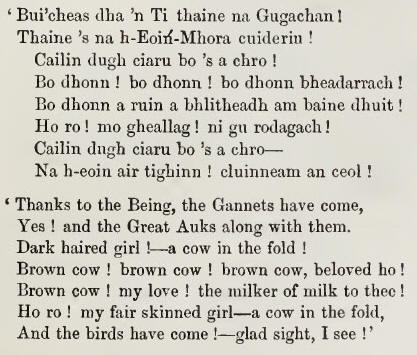
In like manner the people of the Outer Hebrides
are pleased when they see their wild shores strewn with their thrice welcome
sea-weed.
In order to apprise them of the arrival of the
sea-weed, most farms have a loan living near the shore, whose duty it is to
hoist a bundle of ragged sea-weed on the top of a pole. This man is called
Am Peursair, the perchman, and his services are paid in sea-weed and land.
Men and girls, with horses and carts and creels,
labour assiduously in removing the sea-weed beyond reach of the tide. If
they did not, perhaps the next tide might sweep the whole away. In their
eagerness to secure the sea-weed, the people often, with the sea above their
knees, work themselves and their horses altogether too much day after day.
When sea-weed is abundant on the shore, there is
no restriction, but when not abundant, the sea-weed is divided into
Peighinnean, 'pennies,' like their land into rigs, ridges.
Should other work he pressing, perhaps the
landed sea-weed is allowed to ho shove the shore for a time. If so it soon
heats and putrifies, and the smell arising from these innumerable heaps of
corruption is strong and offensive to a degree. However, the bountiful ozone
from the Atlantic counteracts it all, and no harm arises.
If possible, however, the people remove the
sea-weed to the ground without delay, and spread it on their fields. The
people are aware that much of the substance of the sea-weed is thus lost to
them. But they cannot do better.
Throughout the Long Island the crofters keep
stock according to recognised long-established regulations among themselves.
These vary to some degree in various districts. In Lows and Harris the
crofters keep stock according to every pound of rent they pay. This is
called Coir Sgoraidh, grazing-right. Every cow is entitled to her progeny—Bo
he h-al. But the number of progeny to which a cow is entitled is not the
saint everywhere. In some districts the cow is entitled to her calf only, in
noise to her calf and stirk; in some to her calf, stirk, and two-year-old
quey; while in some other districts the cow is entitled to her calf, stirk,
quey, and three-year-old heifer.
This is called Suim, soum, and a man is entitled
to send so many soums to the grazings of his townland. A man's whole stock
is called Leibhidh, and the amount of stock he is allowed to the grazing of
his community is called Sumachadh, souming. Of this Leibhidh he sends so
many soumn to the townland grazing, while he keeps more or less stock of
cows and horses at home on his croft. In the three townlands of Heisgeir,
Hosta, and Caolas Paipil, the tenants are unable to keep any steers at home,
being on the Run-Rig system pure and simple. The people make what they call
a Sumsachadh Sounsing twice a year. The first takes place at Beltain, 1st
May, and the second, after the last of the markets are held, when they have
sold all the stock they care to sell for the year.
In the Uists and Barra the people keep stock
according as they have a whole croft, a half croft, or a quarter croft. Each
croft in the particular townland is entitled to so many soums.
If the stock of a tenant be incomplete it is
called Leibhidh Briste, 'Broken Levy.' In that case the tenant may dispose
of his grazing-right to a neighbour who may have an overstock.
The tenants of a townland will not willingly
allow a fellow-tenant to sell his grazing outside the townland. There are
various things which a tenant can do and which he cannot do; and all these
things, so intricate to a stranger, so easy to themselves, are well defined.
All these stock and land arrangements of the
people show that they could not have been devised by fools; nay, that the
framers of these regulations must have been shrewd intelligent people.
Should a tenant have an overstock of one species
of animals amid an understock of another species, these species are placed
against one another. This is called Coilpeachadh, which for want of a better
term may be called 'equalizing.' In like manner, if a tenant has an
overstock of the old and an understock of the young of the same species of
animals, the young and the old are placed the one against the other and
equalised. After the Coilpeachadh is done, should there still be a balance
against the tenant, he must provide for it specially. This is done by buying
grass from a neighbour who is short of stock, or from a tenant in a
neighbouring townland. Or perhaps his fellow-tenants may allow the man to
retain the extra cow, horse, heifer, stirk, or sheep, as the case may be, on
the grass till he can dispose of it at the market. If so, they will exact
payment for the grazing, and this payment is added to the general fund of
the community towards purchasing fresh stock.
In these and all other matters the people are
forbearing and considerate towards one another, and a man placed in any
difficulty is aided to the utmost by his community. If, however, a man is
obstinate, be is denounced as Fiaeail Oaihhre, gaber tooth, goat tooth,
standing out against the customs of the community.
The Coilpeachadh varies iii some slight degree
in some of the islands. The following table, however, may be accepted as
fairly representing the whole Outer Hebrides
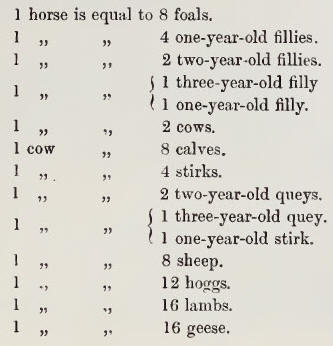
Three one-year-old hoggs are equal to two sheep;
one two-year-old hogg is equal to one sheep, and other modifications.
The young of the horse and the cow arrive at
maturity at four years of age. The old Highlanders never worked nor bred
their horses or cattle till they had arrived at maturity. They said that the
horse, the mare, and the cow lasted twice as long when thus treated. In
Kintail of old, an entire horse was not allowed to work before he was seven
years of age. Probably now-a-days that would be considered waiting too long.
The young of most animals are changed to a new
name on the first day of winter. The foal becomes a Loth or lothag. filly;
the lamb becomes an Othaisg. For these things, and for most, if not indeed
for all things of this nature, 'the old people' had rhymes to assist the
memory. These rhymes are invariably expressive and pithy, although now
becoming obsolete.
The calf changes to a stirk:-

The young are separated from their mothers, and
the new name is applied to them at Hallowisias, Gaelic, Sandsuin.
Having finished their tillage, the people go
early in June to the hill-grazing with their flocks. This is a busy day in
the townland. The people are up and in commotion like bees about to swarm.
The different families bring their herds together and drive them away. The
sheep lead, the cattle go next, the younger preceding, and the horses
follow. The men carry burdens of sticks, heather-ropes, spades, and other
things needed to repair their summer huts (Sgitheil, Bothain). The women
carry bedding, meal, dairy and cooking utensils. Round below their waists is
a thick woollen cord or leathern strap (Crios-f heile, kilt-band),
underneath which their skirts are drawn up to enable them to walk easily
over the moors. Barefooted, bareheaded, comely boys and girls, with gaunt
sagacious dogs, flit hither and thither, keeping the herds together as best
they can, and every now and then having a neck-and-neck race with some
perverse animal trying to run away home. There is much noise. Men—several at
a time—give directions and scold. Women knit their stockings, sing their
songs, talk and walk as free and erect as if there were no burdens on their
backs nor on their hearts, nor sin nor sorrow in this world of ours, so far
as they are concerned. Above this din rise the voices of the various animals
being thus unwillingly driven from their homes. Sheep bleat for their lambs,
lambs for their mothers; cows low for their calves, and calves low for their
dams, mares neigh for their foals, and foals reply as they lightly trip
round about, little thinking of coming work and hard fare. All who meet on
the way bless the 'Trial,' as this removing is called. They wish the 'Trial
' good luck and prosperity, and a good flitting day, and, having invoked the
care of Israel's Shepherd on man and beast, they pass on.
When the grazing-ground has been reached and the
burdens are laid down, the limits are repaired outwardly and inwardly, the
fires are rekindled, and food is prepared. The people bring forward their
stock, every man's stock separately, and, as they are being driven into the
enclosure, the constable and another man at either side of the gateway see
that only the proper soumning has been brought to the grazing. This
precaution over, the cattle are turned out to graze.
Having seen to their cattle and sorted their
shealings, the people repair to their removing feast, Feisd mia h-imrig; or
shealing feast, Feisd na h-airklh. This feast is simple enough, the chief
thing being a cheese, which every housewife is careful to provide for the
occasion from last year's produce. The cheese is shared among neighbours and
friends, as they wish themselves and cattle luck and prosperity.

Every head is uncovered, every knee is bowed, as
they dedicate themselves and their flocks to the care of Israel's Shepherd.
In Barra, South Uist, and Benbecula, the Roman
Catholic faith predominates here, in their touching dedicatory old hymn, the
people invoke, with the aid of the Trinity, that of the angel with the
cornered shield and flaming sword, Saint Michael, the patron saint of their
horses; of Saint Columba the holy, the guardian over their cattle and of the
golden-haired Virgin Shepherdess, and Mother of the Lamb without spot or
blemish.
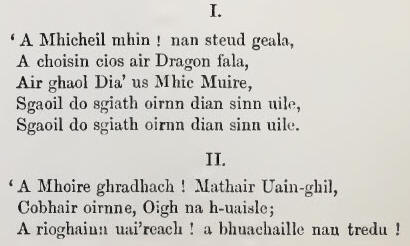
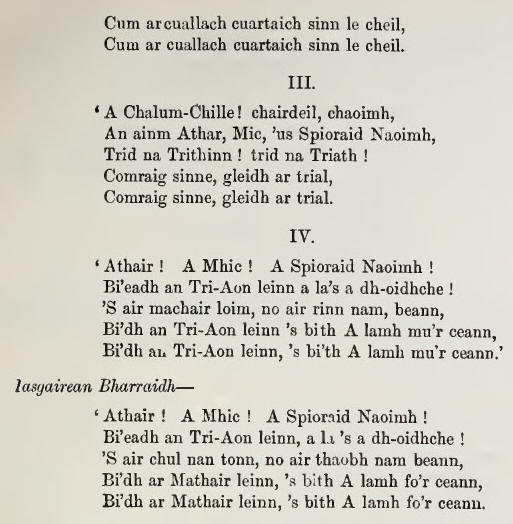
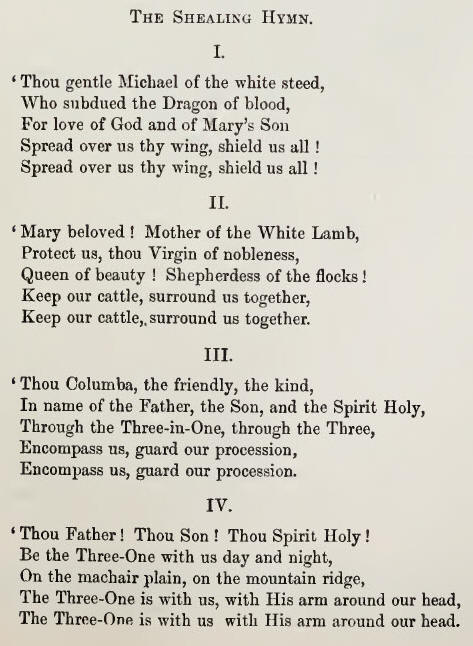
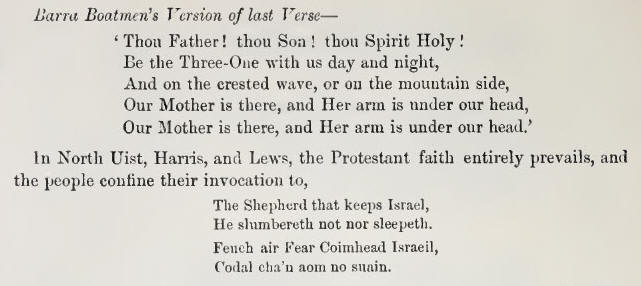
As the people sing their dedication, their
voices resound from their shealings here literally in the wilderness, and as
the music floats on air, and echoes among the rocks, hills, and glens, and
is wafted over fresh-water lakes and sea-lochs, the effect is very striking.
The walls of the shealings in which the people
live are of turf, the roof of sticks covered with, divots. There are usually
two shealings together; the larger the dwelling, the smaller the dairy. This
style of but (Sgithiol) is called Airidh' or shealing, and 'Both cheap,' or
'Bothan cheap,' turf bothy; to distinguish it from 'Both eloic.he' or 'Bothan
cloiche,' stone bothy. This is entirely constructed of stone, the roof
tapering to a cone more or less pointed. The apex of the cone roof is
probably finished off with a flag, through the centre of which there is a
hole like that through an upper millstone, the opening for the egress of
smoke and the ingress of light. There is low doorway with, a removable doom,
seldom used, made of wicker work, wattles, heather, or bent. The walls of
the hut, two, three, or four feet from the floor, are recesses-.--Gaelic,
Buthailt, Scottish 'bole'—for the various utensils in use by the people,
while in the bosom of the thick wall low down near the ground are the
dormitories wherein the people sleep. The entrance to these dormitories,
slightly raised above the floor, is a small hole, barely capable of
admitting a person to creep through. This sleeping access is called 'Cruisa',
from 'Crupailhi,' to crouch. It was a special feature in the architecture of
the former houses of St Kilda, the houses themselves being called 'Crupa'
from this characteristic. These beehive stone houses are still the shealings
of the Lews people. Some are also to be seen the forrest of Harris, but none
in either of the Uists or in Barra. In these places the people have
practically ceased going to the summer shealings. Invariably two or three
strong healthy girls share the same shealing. There they remain making
butter and cheese till the corn is ripe for shearing, when they and their
cattle return home. The people enjoy this life at the hill pasturage, and
many of the best lyric songs in their language are in praise of the loved
summer shealing.
Considerable changes are now taking place among
the people of the Outer Hebrides as to the rearing and the disposing of
stock. Markets are more open to them, and they can sell their stock early,
and of this they take advantage. But under their old conditions, and
considering all their circumstances, which must be weighed before judging,
probably none better than their old systems were ever devised.
In various localities and on various occasions I
made minute inquiries of old people as to the detailed farm stock and
domestic substance of their fathers. The people then had more land and of
better quality; they had more horses, sheep, and cattle; they had more crop,
and of better quality; they had better nourishing food, and they had better
bed and body clothing. They had also more constructive ingenuity in arts and
manufactures, and they had more mental and physical stamina, and more
refinement of manners.
Therefore, go back to the old order of things
under improved conditions. Unloosen their cords, and allow the people to
expand by filling up the central rungs in the land ladder, all of which are
at present absent, rendering it impossible for a crofter, however
industrious, to rise higher than he is. To my thinking it is impolitic, as
well as unjust, to hem the people into a corner, thereby impoverishing the
many to enrich the few. The people of the Outer Hebrides are admirable
workers by sea and land, and if they are less persevering than they might
be, it is the fault of circumstances.
OLD HYMNS
The oral lore of the old highland people is
rapidly dying out with the old people themselves. There is an essential
difference between the old and the young people. The young people are
acquiring a smattering of school education in which they are taught to
ignore the oral literature which tended to elevate and ennoble their
fathers. In his anxiety to rescue what he could of this unwritten literature
of various kinds, the writer has sacrificed promotion several times offered
to him. A few hymns from this mass of old lore are given in this paper at
the desire of the noble Chairman of this Commission, Lord Napier and
Ettrick.
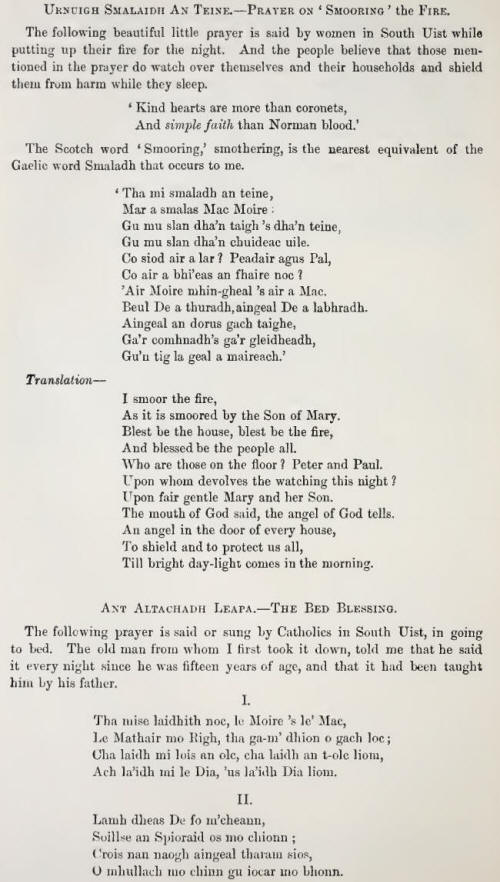
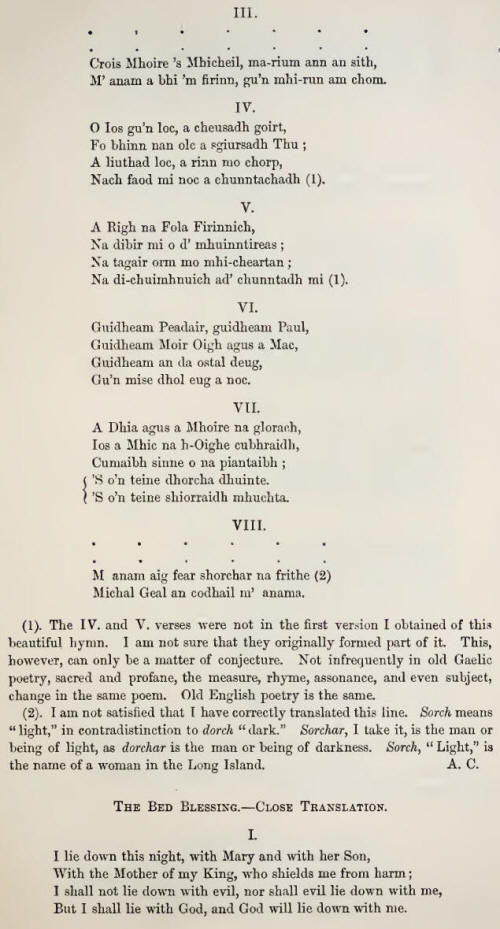
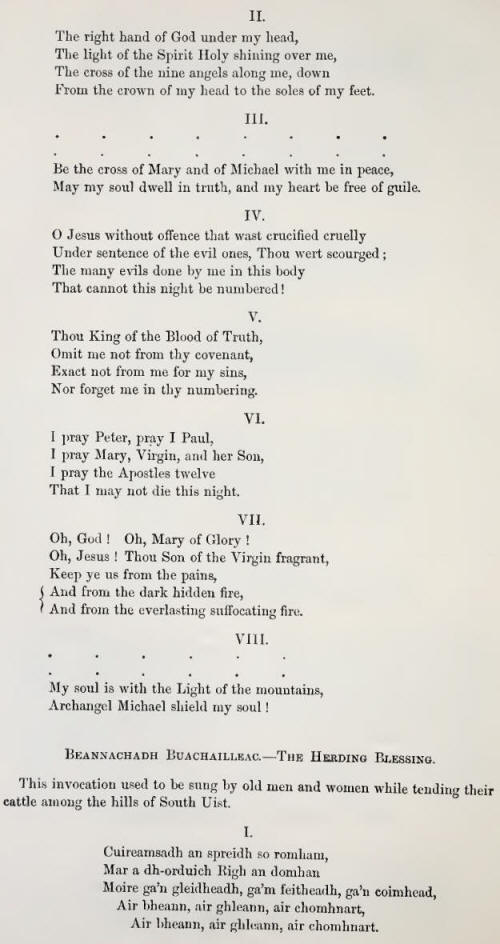
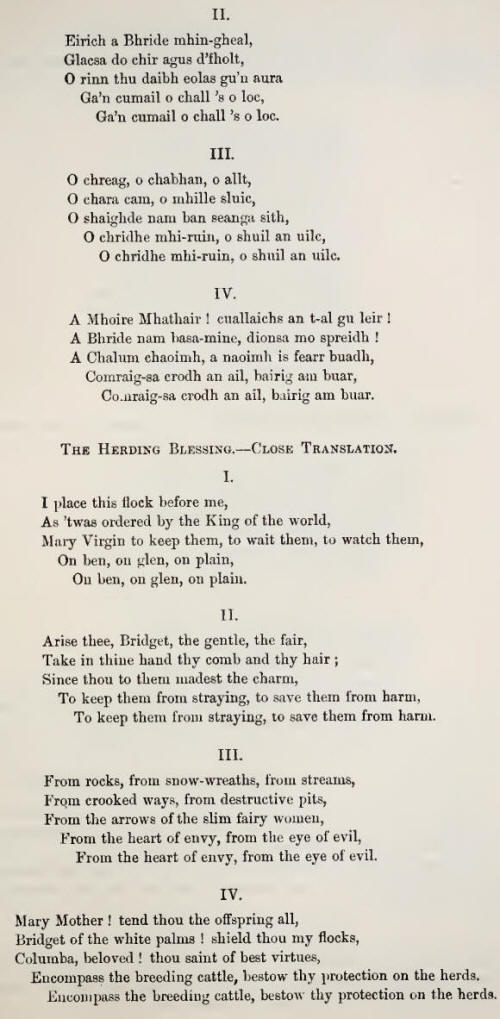
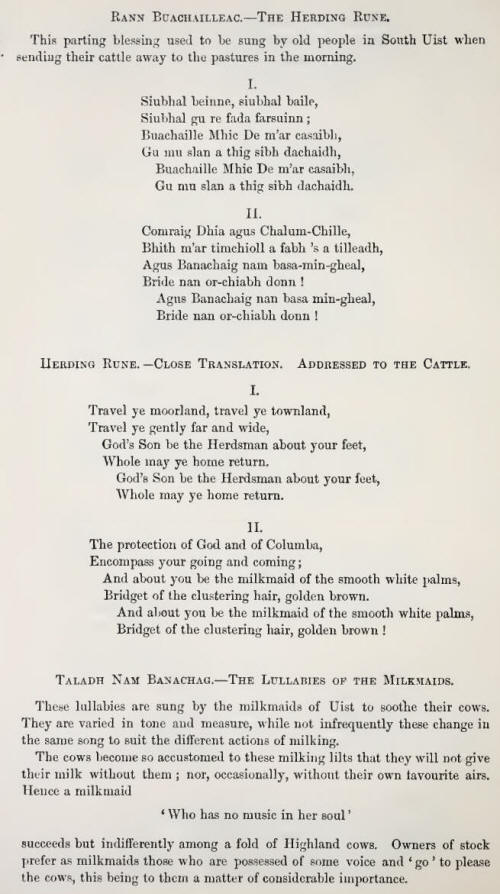
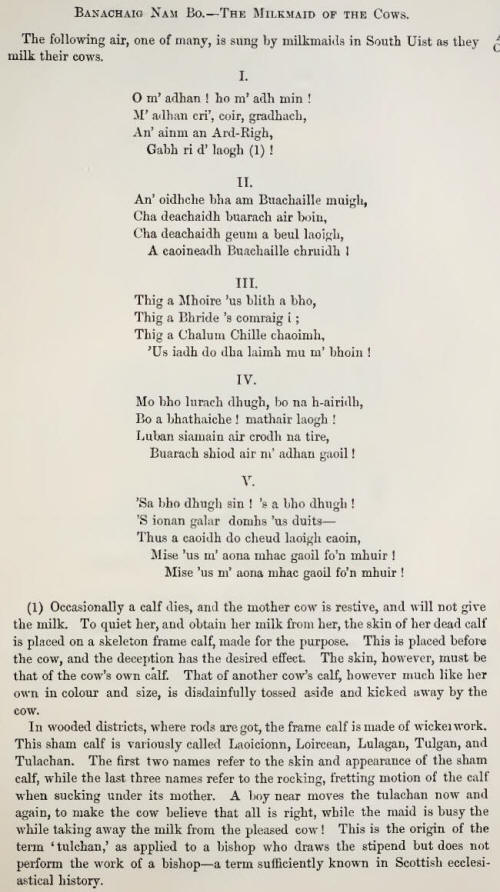
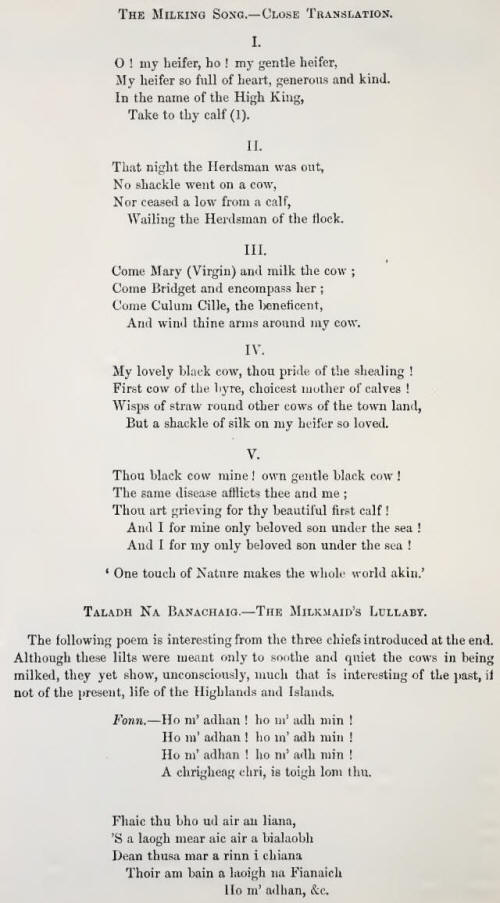
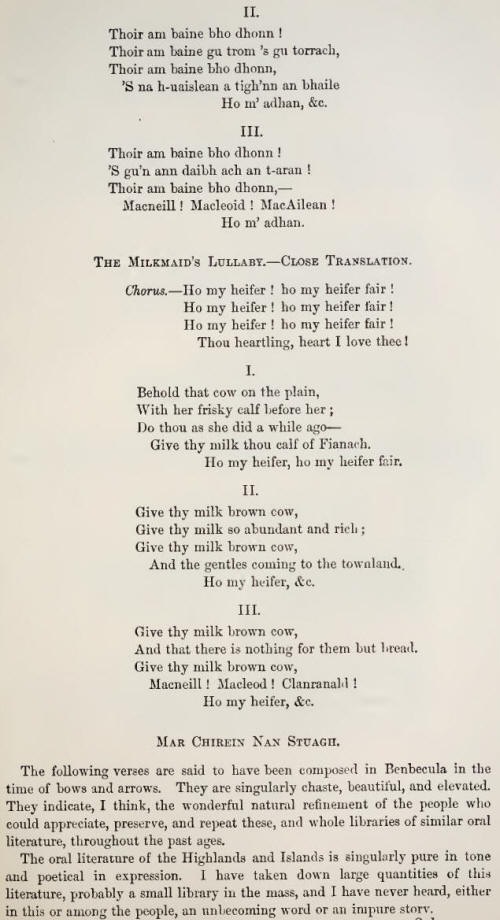
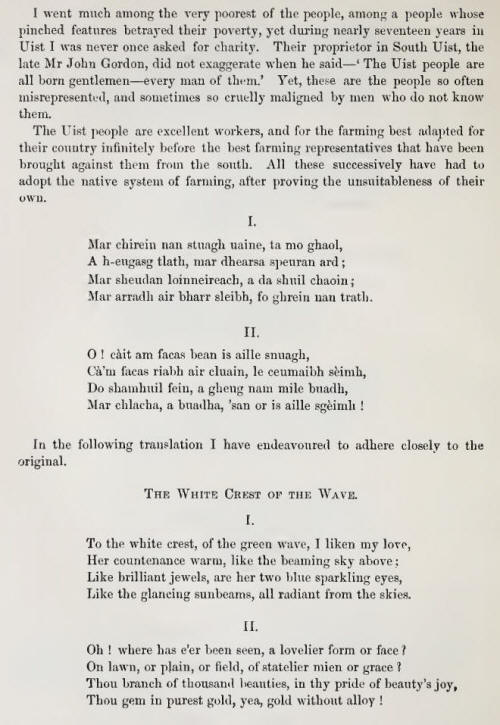 |

